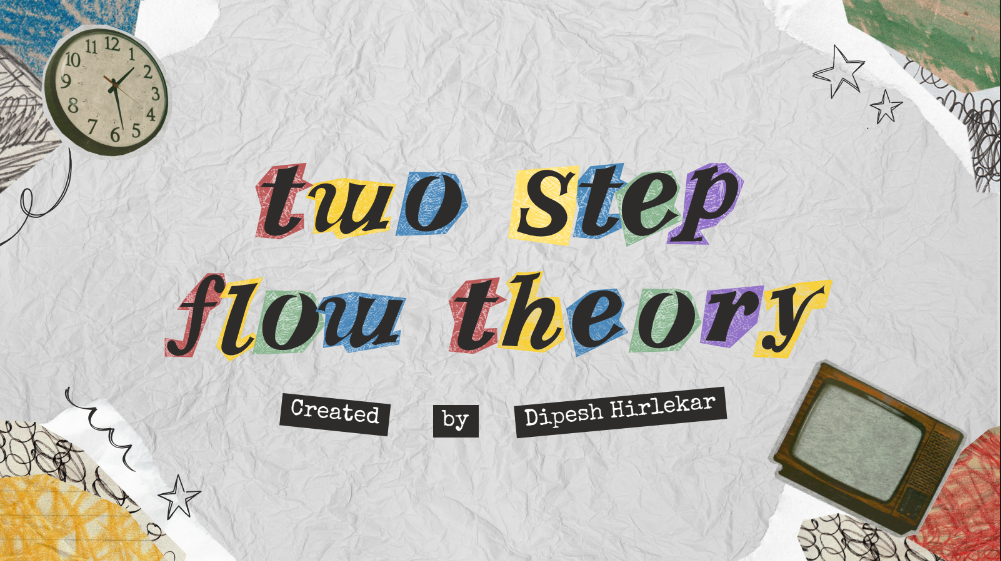The Concept of The Two-Step Flow Theory
The Two-Step Flow theory first proposed by Paul Lazarsfeld and his colleagues in the 1940s. Most of us get our information and are influenced indirectly by trusted opinion leaders who interpret and pass along media messages. This theory initially believed that media information was not directly consumed by the public, but filtered through opinion leaders (i.e. people who influence others’ views in social networks). Although the media environment has undergone tremendous changes since the theory was proposed, the basic concepts still apply, especially in the era of social media influencers and the prevalence of digital communication.

Evolution of Opinion Leaders: From Politics to Social Media
The initial research that led to the emergence of the “two-step mobility theory” focused on the 1940 US presidential election (Robinson, 1976), where people found that they were more likely to be influenced by opinion leaders than through direct media contact. Fast forward to today, opinion leaders have taken on new forms. Although political commentators and journalists still have influence, today’s opinion leaders typically appear on platforms such as Instagram, TikTok, and YouTube.
Li Jiaqi: The Lipstick King and Two-Step Flow in E-Commerce
Li Jiaqi (Austin Li) is a prime example of applying the Two-Step Flow Theory in the realm of e-commerce and livestreaming. Li Jiaqi rose to fame through his live streaming of beauty products, particularly lipsticks, on platforms like Taobao and Douyin (the Chinese version of TikTok), earning him the nickname “Lipstick King” of China.
Li Jiaqi plays the role of an opinion leader for his audience. His followers trust his recommendations, and many make purchasing decisions based on his product reviews. Consumers don’t directly receive information from brand advertisements; instead, they rely on Li Jiaqi to interpret this information, provide personal insights, and recommend the best products. Brands now depend on Li Jiaqi to reach audiences that are hard to engage through traditional advertising.
His streaming not only offers the real-time interactive experience that mass media lacks, but his influence is also built upon exposure through media platforms, further reinforcing the concept that mass media indirectly influences audiences through opinion leaders.
Different Sound From Public
But on the other hand, Li Jiaqi’s immense sales ability has also been criticized for promoting excessive consumption. During events like Singles’ Day in China, the sheer volume of products he promotes has led some to question the sustainability of this model. His success has fueled a narrative of over-consumerism, which may encourage fans to buy more than they need, leading to waste and environmental degradation. Critics argue that opinion leaders have a responsibility to promote conscious consumerism, rather than merely driving sales.
Quick End
In conclusion, the two-step flow theory proposed by Paul Lazarsfield and colleagues in the 1940s remains a key framework for understanding the effects of media. This dynamic still holds true in today’s digital environment, especially with the rise of social media influencers like Austin Li, who play a similar role in e-commerce. But public oncerns about the moral responsibility of opinion leaders and the promotion of overconsumption continue to challenge this model in modern communication.
Case, D.O., Johnson, J.D., Andrews, J.E., Allard, S.L. and Kelly, K.M. (2004). From two-step flow to the Internet: The changing array of sources for genetics information seeking. Journal of the American Society for Information Science and Technology, 55(8), pp.660–669. doi:https://doi.org/10.1002/asi.20000.
Choi, S. (2014). The Two-Step Flow of Communication in Twitter-Based Public Forums. Social Science Computer Review, 33(6), pp.696–711. doi:https://doi.org/10.1177/0894439314556599.
Nisbet, M.C. and Kotcher, J.E. (2009). A Two-Step Flow of Influence? Opinion-Leader Campaigns on Climate Change. Science Communication, 30(3), pp.328–354. doi:https://doi.org/10.1177/1075547008328797.Robinson, J.P. (1976). Interpersonal Influence in Election Campaigns: Two Step-Flow Hypotheses. Public Opinion Quarterly, 40(3), p.304. doi:https://doi.org/10.1086/268307.
Picture Reference: Google.com. (2024). Redirect Notice. [online] Available at: https://www.google.com/url?sa=i&url=https%3A%2F%2Fwww.jasonchatfield.com%2Fblog%2Fcartoons-via-email-vs-social-media&psig=AOvVaw2YqLp8NnRvRhWzQ9fbJbs1&ust=1729692258960000&source=images&cd=vfe&opi=89978449&ved=0CBcQjhxqFwoTCJih2IOUookDFQAAAAAdAAAAABAE [Accessed 21 Oct. 2024].
Bolognini, D. (2022). The Two-Step Flow of Today – Dany Bolognini – Medium. [online] Medium. Available at: https://danyb.medium.com/the-two-step-flow-of-today-4aadc178b629 [Accessed 21 Oct. 2024].


This blog does a fantastic job of linking classic media theory with the modern digital landscape. The Two-Step Flow model’s relevance in today’s age of influencers, especially in e-commerce, is intriguing. It’s fascinating how the model, once primarily applied to political and social opinion leaders, now resonates strongly within influencer marketing. This shift underscores how “opinion leaders” have transformed into figures like livestream sellers, who don’t just influence preferences but also drive direct purchasing behavior.
The discussion on influencers’ dual roles—as both facilitators of consumer choice and potential promoters of overconsumption—is especially timely. It raises ethical questions about the influencer industry and its responsibility to consumers. Given the reach of platforms like Douyin or TikTok, these influencers wield immense influence, and how they navigate that power in promoting consumer culture could reshape public perception of the industry.
The blog opens up room to think about the responsibilities of opinion leaders in e-commerce. Should they balance promoting products with encouraging mindful consumption? It would be interesting to see future discussions on potential regulations or ethical standards for influencers, particularly given their profound influence on public spending and lifestyle choices.